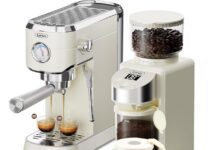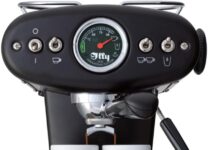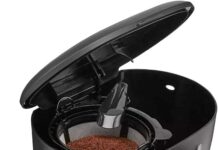In the world of coffee, one question that often arises is whether stovetop coffee is stronger than its counterparts. Many coffee enthusiasts swear by the rich, bold flavors that can be achieved with stovetop brewing methods. In this article, we explore the qualities of stovetop coffee and discover whether it truly packs a stronger punch. Grab a mug and join us as we uncover the secrets of stovetop coffee brewing!
Introduction
Background information on stovetop coffee
Stovetop coffee, also known as moka pot coffee, is a brewing method that has been around for decades. It was invented in Italy by Alfonso Bialetti in the 1930s and has since become a popular choice for coffee enthusiasts who appreciate its strong and rich flavor. Stovetop coffee is brewed by passing hot water pressurized by steam through ground coffee, resulting in a concentrated and robust cup of joe.
Importance of coffee strength for coffee enthusiasts
For coffee enthusiasts, the strength of their cup of coffee is of utmost importance. The strength of a coffee refers to its intensity, boldness, and the level of coffee flavors and aromas that are extracted during the brewing process. The strength of coffee can greatly impact the overall enjoyment and satisfaction of a coffee lover. Whether it be a mild cup to start the day or a bold espresso for an afternoon pick-me-up, understanding and controlling the strength of coffee is key.
Understanding Stovetop Brewing
Overview of stovetop coffee brewing method
Stovetop coffee brewing involves a simple yet effective process. It typically consists of three main chambers – a water chamber, a coffee chamber, and a collection chamber. As heat is applied to the water chamber, the steam generated builds up pressure, causing the hot water to rise through a tube and pass through the coffee grounds in the coffee chamber. The brewed coffee then collects in the collection chamber, ready to be enjoyed.
Explaining the stovetop coffee maker
The stovetop coffee maker, also known as a moka pot, is a classic kitchen tool that has become a staple for many coffee lovers. It is made of aluminum or stainless steel and is specifically designed to withstand the high temperatures and pressures required for stovetop brewing. The design typically consists of a bottom chamber for water, a middle chamber for coffee grounds, and a top chamber for the collection of brewed coffee.
Steps to brewing stovetop coffee
Brewing stovetop coffee is a straightforward process that can be easily mastered. Here are the steps to get that perfect cup:
- Fill the bottom chamber with cold water up to the safety valve level.
- Insert the coffee grounds into the middle chamber, ensuring a level surface without any compacting.
- Screw the top chamber tightly onto the coffee chamber, ensuring a proper seal.
- Place the stovetop coffee maker on a heat source, such as a stovetop or gas burner.
- Heat the coffee maker over medium heat until the water in the bottom chamber reaches a boiling point and steam is generated, which will then pass through the coffee grounds.
- Monitor the brewing process closely to ensure you remove the coffee maker from the heat as soon as the brewing is complete.
- Allow the coffee maker to cool slightly before unscrewing the top chamber and pouring the brewed coffee into your cup.
Strength Factors in Coffee
Defining coffee strength
When we talk about coffee strength, we are not referring to the caffeine content, but rather the intensity and concentration of flavors and aromas extracted during the brewing process. A strong coffee typically has a bold and robust taste, while a weaker coffee may have a milder flavor profile. Coffee strength is often subjective, as each individual may have their own preferences when it comes to the strength of their coffee.
Factors influencing coffee strength
Several factors come into play when determining the strength of a cup of coffee. These factors include the coffee-to-water ratio, extraction time, grind size, water temperature, and pressure. Understanding how these factors affect coffee strength is crucial in achieving the desired flavor profile.
Brewing variables affecting strength
Controlling brewing variables is the key to achieving the desired strength in your cup of stovetop coffee. Coffee-to-water ratio, extraction time, grind size, water temperature, and pressure can all be adjusted to influence the strength of your brew. Experimenting with different combinations and finding the perfect balance of these variables will allow you to tailor the strength of your coffee to your personal taste preferences.
Coffee-to-Water Ratio
Importance of ratio in determining coffee strength
The coffee-to-water ratio plays a significant role in determining the strength of your brew. It refers to the amount of coffee grounds used relative to the amount of water. A higher coffee-to-water ratio will result in a stronger, more concentrated cup of coffee, while a lower ratio will produce a milder cup.
Different ratios for stovetop and other brewing methods
The coffee-to-water ratio for stovetop coffee is commonly recommended to be approximately 1:12, meaning one part coffee to twelve parts water. This ratio is slightly higher compared to other brewing methods like drip or pour-over, where a ratio of 1:15 or 1:16 is often preferred. The higher ratio in stovetop brewing ensures a stronger and more robust flavor.
Effects of altering coffee-to-water ratio
Adjusting the coffee-to-water ratio can have a significant impact on the strength and taste of your stovetop coffee. Increasing the amount of coffee grounds relative to the water will result in a stronger brew, while decreasing the ratio will yield a milder cup. It’s important to note that altering the ratio may also affect the balance of flavors and potentially result in a more bitter or weaker cup, depending on your preferences.
Extraction Time
Role of extraction time in coffee strength
The extraction time, or the duration for which the hot water is in contact with the coffee grounds, directly affects the strength of the brewed coffee. A longer extraction time allows for a higher degree of flavor extraction, resulting in a stronger cup, while a shorter extraction time may produce a milder brew.
Comparison of stovetop brewing time with other methods
Stovetop brewing generally takes around 4-5 minutes from the moment the water begins to boil until the brewing process is complete. This extraction time is relatively shorter compared to other brewing methods like pour-over or French press, which often require a longer brewing time. The shorter extraction time in stovetop coffee brewing contributes to its distinctive strength.
Effects of longer or shorter extraction time
Extending the extraction time in stovetop brewing by leaving the coffee maker on the heat for longer will result in a stronger and more intense cup of coffee. Conversely, reducing the extraction time by removing the coffee maker from the heat sooner can yield a milder and less concentrated brew. Finding the perfect balance of extraction time that suits your taste is essential in achieving your desired strength.
Grind Size and Strength
Influence of grind size on coffee extraction
The grind size of the coffee grounds plays a crucial role in the extraction process and ultimately affects the strength of the brewed coffee. Finely ground coffee allows for more surface area contact with the water, resulting in a quicker and more thorough extraction. Coarser grounds, on the other hand, require a longer extraction time to achieve comparable results.
Recommended grind size for stovetop coffee
For stovetop coffee brewing, a medium-fine grind is generally recommended. This grind size strikes a balance between finer espresso grounds and coarser drip coffee grounds. It allows for sufficient flavor extraction within the relatively shorter brewing time of stovetop coffee while still producing a strong and robust cup.
Determining ideal grind size for desired strength
Experimenting with different grind sizes can help determine the ideal grind size for your desired strength of stovetop coffee. If the coffee is too weak for your taste, a finer grind may be needed to enhance extraction. Conversely, if the coffee is too strong or bitter, a coarser grind may be required to reduce extraction. Fine-tuning the grind size allows you to have more control over the strength and flavor of your brew.
Temperature and Strength
Impact of water temperature on coffee extraction
Water temperature is a critical factor that affects the strength and flavor of coffee. The ideal temperature for brewing stovetop coffee is around 195-205°F (90-96°C). If the temperature is too low, the extraction process will be less efficient, resulting in a weaker cup. On the other hand, if the temperature is too high, it can lead to over-extraction, causing a bitter and unpleasant taste.
Stovetop brewing temperature compared to other methods
Stovetop brewing typically reaches the ideal temperature range due to its direct heat source. This sets it apart from other brewing methods like cold brew or iced coffee, where the brewing temperature is significantly lower. Stovetop coffee benefits from the higher temperature, allowing for a more effective extraction and a stronger cup.
Effects of varying temperature on coffee strength
Varying the water temperature in stovetop brewing can impact the overall strength of the coffee. Lowering the temperature even slightly can result in a weaker and less flavorful brew, while increasing the temperature may lead to a stronger but potentially bitter cup. It’s crucial to find the right balance to achieve the desired strength without compromising the taste.
Pressure and Strength
Role of pressure in stovetop coffee brewing
The stovetop coffee maker utilizes pressure generated by the steam to force hot water through the coffee grounds, contributing to the extraction process. The pressure plays a significant role in the strength and intensity of the brewed coffee, as it aids in extracting the flavors and oils from the grounds more efficiently.
Stovetop percolators versus other brewing devices
Compared to other brewing devices like espresso machines, stovetop coffee makers generate lower pressure levels. Espresso machines typically operate at higher pressures (around 9 bars), resulting in a more potent and concentrated cup of coffee. However, the lower pressure in stovetop brewing is still sufficient to produce a satisfying and robust brew.
Relationship between pressure and coffee strength
The pressure exerted during stovetop coffee brewing influences the extraction process and ultimately impacts the strength of the coffee. Higher pressure can yield a stronger and more full-bodied cup, while lower pressure may result in a milder brew. Although stovetop coffee makers may not reach the same pressure levels as espresso machines, they still offer a distinct and flavorful strength.
The Myth of Stovetop Coffee’s Extra Strength
Addressing the common perception of stovetop coffee’s strength
There is a common misconception that stovetop coffee is significantly stronger than other brewing methods, particularly in terms of caffeine content. However, it’s important to note that the caffeine content of coffee is primarily determined by the type of coffee beans used and not the brewing method. Therefore, while stovetop coffee may have a bold and robust flavor, it does not necessarily contain more caffeine than other brewing methods.
Understanding the reasons behind the misconception
The perception of stovetop coffee being stronger may arise from the concentrated and intense flavor it produces. The combination of the brewing variables discussed, such as the higher coffee-to-water ratio, shorter extraction time, and use of pressure, contribute to the bold taste of stovetop coffee. This robust flavor can be mistaken for higher caffeine content, leading to the misconception of stovetop coffee’s extra strength.
Conclusion
Summary of key findings
In conclusion, stovetop coffee offers a strong and flavorful brewing method that is popular among many coffee enthusiasts. The strength of stovetop coffee is determined by various factors, including the coffee-to-water ratio, extraction time, grind size, water temperature, and pressure. Adjusting these variables allows for customization of the strength and flavor profile of the brew to suit individual preferences.
Considerations for choosing stovetop coffee
When choosing stovetop coffee as your preferred brewing method, it is vital to consider your taste preferences and the convenience of the brewing process. Stovetop coffee provides a robust flavor and a relatively quick brewing time. It’s important to note that while stovetop coffee delivers a strong and flavorful cup, it does not necessarily contain higher caffeine content than other brewing methods.
Final thoughts on the strength of stovetop coffee
Stovetop coffee offers a delightful and robust brewing option for coffee enthusiasts seeking a strong and flavorful cup. By understanding the various factors that influence the strength of stovetop coffee, such as the coffee-to-water ratio, extraction time, grind size, water temperature, and pressure, you can achieve your desired boldness and intensity. Experimentation and personal preference play a key role in finding the perfect strength to suit your taste. So go ahead, grab your favorite stovetop coffee maker, and enjoy the rich and flavorful journey of stovetop brewing!





































